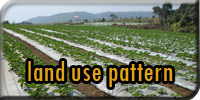 Land Use Pattern
Land Use Pattern
Land use pattern is envisaged on land capability profile.
Since land capability in the mountainous region is determined by the characteristics of micro and mini watersheds, land use pattern is therefore envisaged on the capabilities of each watershed and thus the potential of each watershed is thus envisage to be developed to yield sustainable land use.
Broadly the low lying areas were put under paddy during Kharif and with pulses, paddy, vegetables and oilseeds during the Rabi season depending on the availability of residual moisture and irrigation facilities.
Gentle slopes up to 20% were put under other crops like wheat, paddy, maize, pulses, oilseeds, vegetables etc, which not only contribute towards food security but also yield substantial revenue returns per unit of land and labour.
On such slopes the concept of watershed management of land and water would be encouraged.
Horticulture was taken up on slopes above 20% and Border Areas, which are traditional horticultural areas, received special attention.
Forest cover in the State (42.01%) is below the national norm of 60% recommended for hilly areas.
This is because a sizable proportion of the Forest area is reportedly under shifting cultivation resulting in depletion of the Forest Cover.
A very meagre proportion of the geographical area (9.90%) is net sown area, including area under shifting cultivation. The potential net sown area could be increased if and when the fallow lands are utilised for cultivation purposes.
The cultivable waste land of the state is 20.63% of the geographical area a part of which might be progressively utilised for cultivation purpose in the long run. The cropping intensity of the state is 120%.





